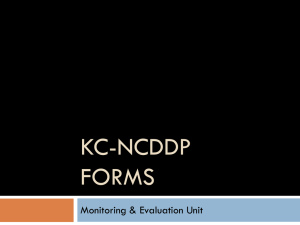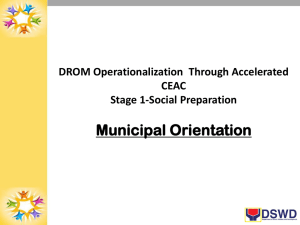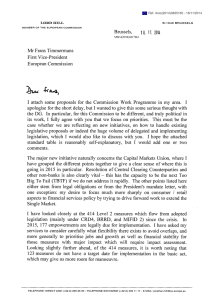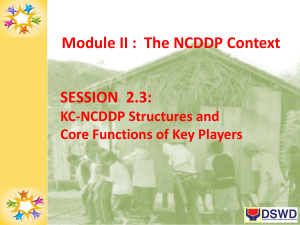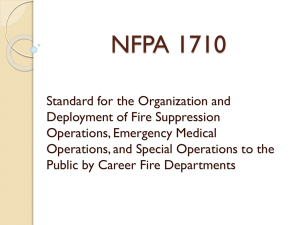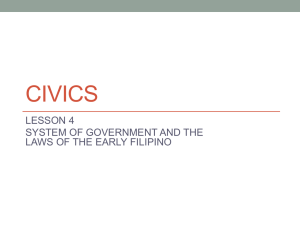Project Proposal Development
advertisement
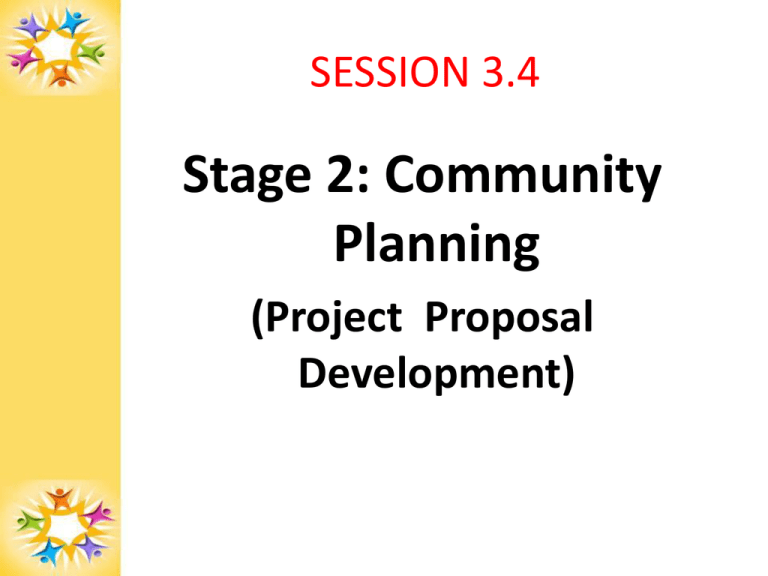
SESSION 3.4 Stage 2: Community Planning (Project Proposal Development) Objectives At the end of 3 hours and 45 minutes, the participants will be able to: • contextualize the project proposal preparation in the Project Development Cycle (PDC) and KC- NCDDP • prepare a community project proposal for KC-NCDDP using the prescribed format and its required attached documents 3. identify the objectives, outputs and activities of the following: • project proposal preparation and technical review • barangay assembly • Approval of project proposals • describe the composition, roles and tasks in various activities of the following committees: • Area Coordinating Team (ACT) • PPT • Municipal Interagency Committee (MIAC) • RPMO • MLGU • NGA • BRT • BSMDC • Regional Project Management Office (RPMO) • NPMO • SRPMO • CEF Outputs/KRAs A. Participants’ common understanding on the importance, process and outputs in the preparation and review of project proposals, barangay assembly for approval of proposals and conduct of MIBF for prioritization B. Filled out Subproject Proposal form with the required 1 or 2 attached documents C. ACT’s workplan for TA assistance on: – Technical review of Project Proposal – Barangay Assembly for Final Proposal Approval D. Participants’ basic and or enhanced skills in formulating project proposal Content A. Project Proposal Definition and its Components in the Context Project Development Cycle and KC- NCDDP B. Preparation of Subproject Proposal and Attached Documents (Filled out form) 1. Name of Proposed Subproject and Category • Rationale 2. Technical Description • Physical target • Cost parameters • Proposed Scope of Work • Human resource requirements • Equipment requirements - Procurement methods to be used 3. Financial /Economic Aspect • • • Estimated Cost Cost Sharing Arrangement Household Information (see form for details) 4. Safeguard Concerns ( see form for details) 5. Sustainability Content C. Objectives, Outputs and Key Activities of : Proposal Preparation, Technical Review, Barangay Assembly and MIBF D. Composition and Roles of the following committees in project proposal preparation: • • • • • • • Area Coordinating Team (ACT) PPT Municipal Interagency Committee (MIAC) Regional Project Management Office (RPMO) NPMO SRPMO CEF E. ACTs Roles and Tasks in the Conduct of technical review – BA Key Messages A. Project Proposal is the document that translates project concepts into concrete and doable action-oriented interventions of the identified priority needs and problems of the community. B. Teamwork and multidisciplinary membership of the project proposal team are crucial in project preparation Key Messages C. Project proposal prepared by the community should primarily focus on the functional use of the proposed facility that addresses peoples’ identified needs in consideration of project standards. D. ACTs’ effective facilitation in project proposal preparation and technical review geared towards producing quality outputs demands good preparation. Preparatory Tasks for Project Proposal Development Area Coordinator • meeting with RPMO and SRPMO to coordinate on the activities, process, date and venue of PDW • ensure availability of adequate technical staff based on consolidated TA and staff augmentation needs identified in community consultations and BA • Ensure availability of funds and other logistical requirements • meet with MLGU, MIAC and NGA partners to groundwork for technical support during PDW Preparatory Tasks for Project Proposal Development ACT Engineer and AC • meet with BRT - Procured TA providers and orient them on the PDW and their expected roles and tasks in this workshop • CEF • meet with PPT for the data to be used during the PDW Actual Project Development Activities 1. conduct interbarangay project development workshop (PDW) ACT gives overviews on: project development process environmental and social safeguards’ guidelines and requirements documentary requirements for the request for fund release (RFR) 2. group barangays by proposed project types – – – – – Type 1: Type 2: Type 3: Type 4: Type 5: vertical structures (community infra) access infrastructure water and sanitation common service facilities and livelihood support projects other projects not within the 4 project types Actual Project Development Activities 3. Conduct workshops to prepare/validate preliminary project concepts with indicative costs – PPT 4. MIAC reviews project concepts. Provide inputs and guidance in preparing final project proposal 5. PPTs prepare action plan to finalize preparation of full proposal, technical plan and other RFR requirements 6. Project TF and MFAs with TA providers in coordination with CEFs and PPTs conducts Community Volunteers Training (CVT) on community procurement and community finance management Actual Project Development Activities ACT, MLGU and MIAC conduct site visits and workshops to assist PPTs’ finalization of proposals, technical plans, detailed cost estimates and other documents following action plans prepared by PPTs 7. Post Project Development Activities 1. ACT and MCT CEFs meet with the BLGU, PPTs and BRTs to finalize plans and schedules for the community consultation on the final proposal 2. Manuals, tools and visual aids to be used in the community consultation as prepared together with the PPT and BRT 3. CEFs conduct simulation and role play with the PPTs and BRT’s to prepare them for presenting the proposal to the community for validation and approval 4. Reflection session with the BRT and the PPT are conducted What is Proposal Preparation Formulation in KC-NCDDP ? “It is a process undertaken by the PPT in their respective barangays after the PDW, which involves preparation of detailed and complete community proposals for their preferred projects”* Specifically, it entails detailed preparation and refinement of: technical design /description of a proposed project, program of work detailed budgeting of project costs organizational aspect & roles/tasks of project implementors feasibility analysis (as needed for bigger projects) subproject economic analysis (as needed particularly for bigger projects) timetable for the project This is the 2nd stage of project development cycle which details the project concept in the 1st stage of PD cycle. *Source: Draft KC-NCDDP OM The PROJECT CYCLE Considerations for Development of Community Project Proposals Barangay profile Name of Barangay: Hilwan IP community 28kms South of Poblacion, Tapaz Mountainous, Military reserve 2hrs ride (motorycle), 4 hours walk 110 HHs, 3500Males, 3000 females Degree of Damage Balay Turun-an : Totally Damage : Sub-project name: Restoration of “Balay Turun-an” a tribal center of Panay Bukidnon FORMAT OF THE COMMUNITY PROJECT PROPOSAL in KC-NCDDP Context 1.The problem Statement/Rationale of Project: The statement areas answers the following questions: a. What is the situation in the community? b. What is/are the problems or development challenges/s faced? c. How does the problem/development challenge affect the community? FORMAT OF THE COMMUNITY PROJECT PROPOSAL cont. 2. The proposed solutions/ objectives: • What needs to be done (proposed solutions) to address the problem? • Formulated in project objectives Source: CEAC Filed Guide FORMAT OF THE COMMUNITY PROJECT PROPOSAL cont. 3. Project/description & Implementation Plans and Arrangements: a.What is the scope of proposed project? b.What are the key activities to implement this project (and even each component)? c. What is/are the organizational arrangements for implementation? d.Who will implement? e.What are the decision-making arrangements and processes? f. What are the control systems and transparency arrangements? Source: CEAC Field Guide FORMAT OF THE COMMUNITY PROJECT PROPOSAL cont. Implementation Plans (strategies, systems/procedures task assignments) Community volunteers to describe: a. how the project and its specific components will be implemented; b. Who will be tasked to implement specific activities and oversee the implementation of the project as a whole; and c. What the implementation systems, processes, and procedures. Source: CEAC Filed Guide FORMAT OF THE COMMUNITY PROJECT PROPOSAL cont. 4. Sustainability plans: Key questions that need to be considered are the following: a. Organizational Development and Management arrangements for implementation and management (ODM) b. Development of local technical skills and competencies for implementation, operation and maintenance (to projects with infrastructure and/or equipment components) and management c. Resources mobilization and accessing, and financial development and management FORMAT OF THE COMMUNITY PROJECT PROPOSAL cont. 5. Component for KALAHI-CIDSS funding: Focus on the specific component that will be proposed for funding from KALAHI-CIDSS • Once the component for proposed KC funding id identified, this component will then be the subject for the preparation of the Sub-project Concept Form (or SPCF) FORMAT OF THE COMMUNITY PROJECT PROPOSAL cont. 6. Proposal Attachments: a. The Sub-Project Concept Form- which all proposals will necessarily have as this is the basis for determining the cost of the specific component proposed for KC funding; b. Feasibility Study-especially for Community Enterprise projects, including those with common service facility components; c. Simple Economic Analysis-especially for infrastructure projects or community projects with common service facility components; FORMAT OF THE COMMUNITY PROJECT PROPOSAL cont. 6. Proposal Attachments cont.: d. Action Plan-especially for Human Resource Development )HRD) or Community Enterprise projects; e.Program of Works or POWespecially for infrastructure or Community Enterprise with common service facilities; FORMAT OF THE COMMUNITY PROJECT PROPOSAL cont. 6. Proposal Attachments cont.: f. Procurement Plan-especially for infrastructure or Community Enterprise projects with common service facilities or equipment purchase requirements g.Technical Plans-especially for infrastructure or community enterprise projects with common service facility components Objectives of Proposal Formulation with Community Groups This is intended to: • mobilize community groups to undertake the task of proposal preparation in constant consultation with community members. • mobilize the MIAC and NGA personnel to provide technical assistance to community groups • prepare community groups and members for engagement with the LPRAT Output: • Prepared Project / Subproject Proposal with required documents and costing based on KC-NDCCP format ACT’s Roles in Proposal Preparation • Ensure that PPTs and other community volunteers are provided with timely technical assistance throughout the process of proposal preparation • Provide training to PPT members in proposal development based on Municipal Forum approved results and prioritization • Facilitate the conduct of: PDW interbarangay technical review of completed proposals by MIAC • Assist the BRT and PPT to finalizing their action planning Municipal Inter-Agency Committee (MIAC’s) Roles • Conduct a technical review of the prepared proposals • Make suggestions (if any) for revision/improvement of proposals • Provide technical support to CVs/PPTs in proposal preparation Composition of MIAC • Municipal Mayor • Vice Mayor (or a member of Municipal Council who represents SB • Local Poverty Reduction Officer (LRAO) • Municipal Planning & Development Officer (MPDO) • Municipal Budget Officer (MBO) • Municipal Engineer (ME) • Municipal Health Officer (MHO) • Municipal Agrarian Reform Officer (MARO) or • Municipal Agriculture Officer (MAO) • Other locally mandated organizations & local Special Bodies (Optional) BRT Roles • Present the project proposals during barangay assembly (BA) • Presents community approved project proposal during 2nd MIBF CF Roles • Undertake the groundwork & other necessary preparations for the barangay assembly • Ensure 80% participation rate in BA • Assist BRT & PPT in finalizing their presentation of community project proposals during BA BSPMC – Barangay Sub-Project Management Committee • Composed of smaller committees tasked to implement specific activities in project implementation. This can include teams in: – procurement – monitoring – audit & inventory – operation & maintenance – membership – etc. Technical Review of Proposal Objectives 1. To ensure that the proposal meets the standards for safety and safeguards 2. To ensure that the project meets the technical standards and requirement of the NCDDP Technical Review of Proposal Participants to the technical review • PPTs, • ACT, • MCT, MIAC • Barangay Captain • members of the barangay council • representatives of the City LGU • Representatives for Pos, CSOs The technical review shall be facilitated by the ACT Output of the Technical Review 1. Final recommendations for enhancements 2. Barangay Assembly preparations Review of Technical Proposal Methodology and Approaches 1. Guarantee that the project proposals are sound and viable with certainty of support and financing from NCDDP and other funding sources such as the BUB. 2. MIAC provides TA and does not decide on the project. The MIAC review is meant to improve the community proposals and therefore increase the successful implementation. Barangay Assembly for Approval of Proposal • • • • Objectives Review and endorse the final proposal for presentation to MIB Gather local counterpart contribution for the project Review the multi-year prioritization plan for advocacy to the MDC Agreement on the action plan in case community project is not prioritized Barangay Assembly for Approval of Proposal 1. 2. 3. 4. 5. Participants 80% of HH populations in the barangay Barangay Chairman and council members ACT, BDC, MCT, MIAC Representatives from the LGU (municipal, provincial, congressional) Representatives from CSOs, POs, IPs Barangay Assembly for Approval of Proposal Outputs • Approved Final Proposal for MIBF presentation • Approved Multi-Year Prioritization Plan • Agreement on Local Counterpart • Agreement on Action Plan if not prioritized Roles and Tasks of ACT ACT Roles • Mobilize MIAC • Facilitate Technical Review • Assess Quality of Proposals and attachments • Facilitate Community Assemblies • Assist PPT and BRT to finalize presentation Application A. Preparation of Project Proposal using the prescribed format (filling out project proposal form and attached documents) See attachment.


